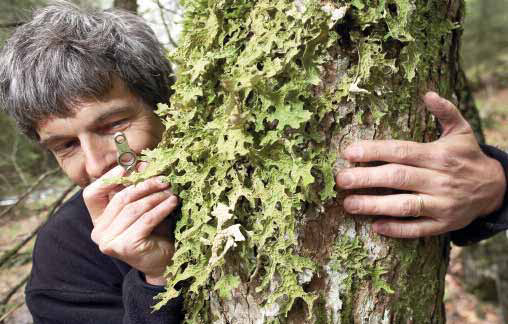Lungwort (Lobaria pulmonaria) is traditionally used as a cure for coughs. It grows on the bark of old deciduous trees, especially on maple and common beech, in woods rich in rain. Lungwort has, like many other species of lichen, practically disappeared from the intensively used lowland forests of central Switzerland. Here the practice of felling trees early prevents the lichens from optimally spreading out. Today, in Switzerland, lungwort can only be found in the Prealps and the Jura. However, even here it is nearly impossible for them to spread out if there are only a few carrier trees in the forests.
Lungwort is stringently protected because it is a threatened species. It is now being considered whether lichen growth could be promoted whilst at the same time they were being restrictively used. On behalf of the Federal Office for the Environment (FOEN) Christoph Scheidegger from the Federal Institute for Forest, Snow and Landscape Research (WSL) is trying to ascertain how this could be put into practice. The lichen specialist sees a good chance of success. From trials he knows how lichen regeneration could succeed: during collection the whole individual must not be removed, as is done in traditional harvesting. The upper tissue edge must remain on the trunk. From this remaining ca. 20 percent of tissue the lungwort is able to regenerate.

Lungwort is endangered. To help protect it lichen specialist Christoph Scheidegger recommends using the species commercially as a medicinal plant.
Photo: BAFU/AURA
Lichens are special organisms: They are made up of fungi and algae. Together with fungal threads the algal cells form a biotic community. To be able to exist this "team" needs only light and humidity. However, more than one third of lichens in Switzerland are endangered.
==> Lichen Red List
Lichens grafted onto new carrier trees
Users could also encourage further spread by grafting special fragments from the lower edge of the harvested lichen onto appropriate tree trunks. After 5 to 30 years the lungwort will have matured enough to allow a new harvest.
With a large labour force and much patience the number of carrier trees and therefore the lichen population could be increased. Such laborious species protection could be achieved as a by-product of commercial usage with the participation of the forestry service. Collection permits must however contain specific stipulations.
So that the source does not dry up
The company Weldeda AG in Arlesheim is interested in acquiring a collection permit. They produce a cough syrup and need around one hundred kilogrammes of lungwort per year. “It is getting harder to get hold of lichens and in the long term there is no guaranteed supply,” explains the company’s head of plant procurement Andreas Ellenberger. He therefore suggests that collection, coupled with promotion measures, should be made possible in Switzerland.
For Ellenberger it is important to combine use with species protection in order to conserve nature’s long term supply. This manufacturer of medicinal and care products is at present procuring its supply of lungwort from France and Canada, where it is not protected. Swiss stocks alone would not however cover the company’s needs. It would therefore be necessary to carry on importing. These imports should also be subject to the same stipulations in order to guarantee a sustainable supply.
Maintaining habitat
Lichens are symbiotic fungal algal networks. In Switzerland they are mainly on the decline. This can be seen in the 2002 published lichen red list, in which the WSL biologist Scheidegger was significantly involved. 44 % of the 520 recorded tree lichens are threatened. 22 species are no longer to be found in any region of Switzerland.
These notably slow growing organisms cannot cope with changes in their habitats. Many endangered tree lichens need light and near to nature forests with a large, aged wood stock. “In the case of lichens species protection also means primary protection of habitat”, points out Christoph Scheidegger. Rare lichens also help to conserve richly structured forests with interesting flora and fauna.
